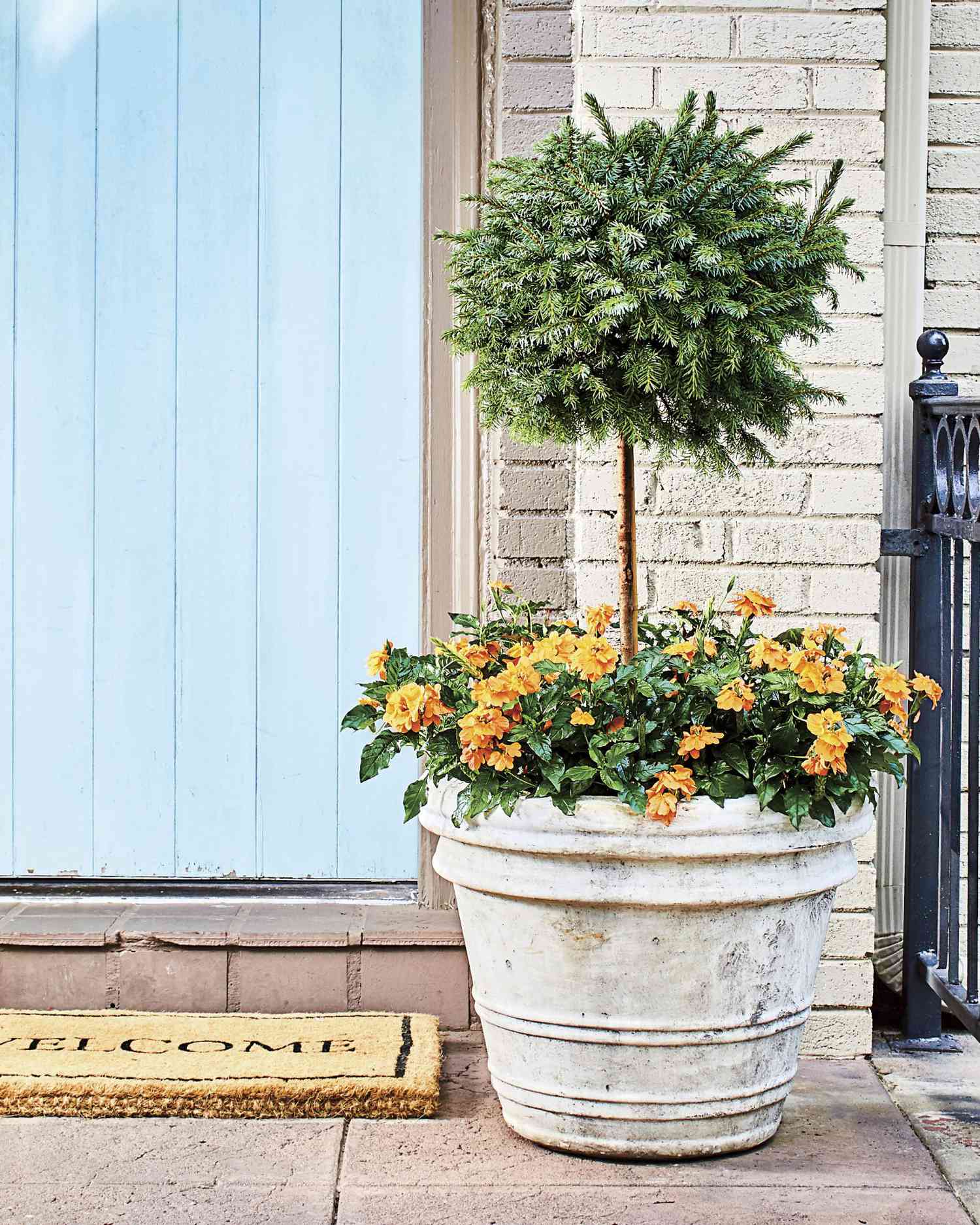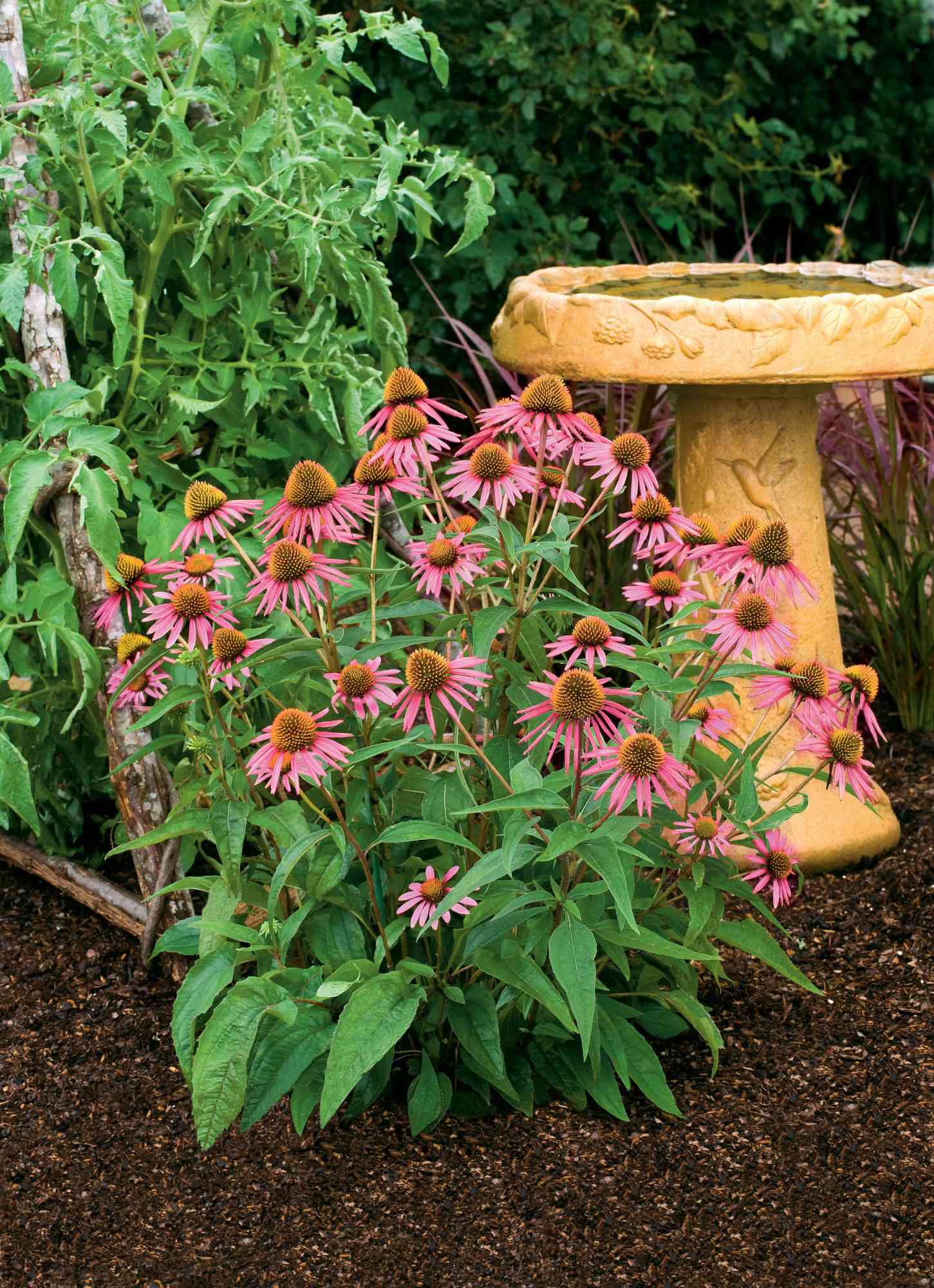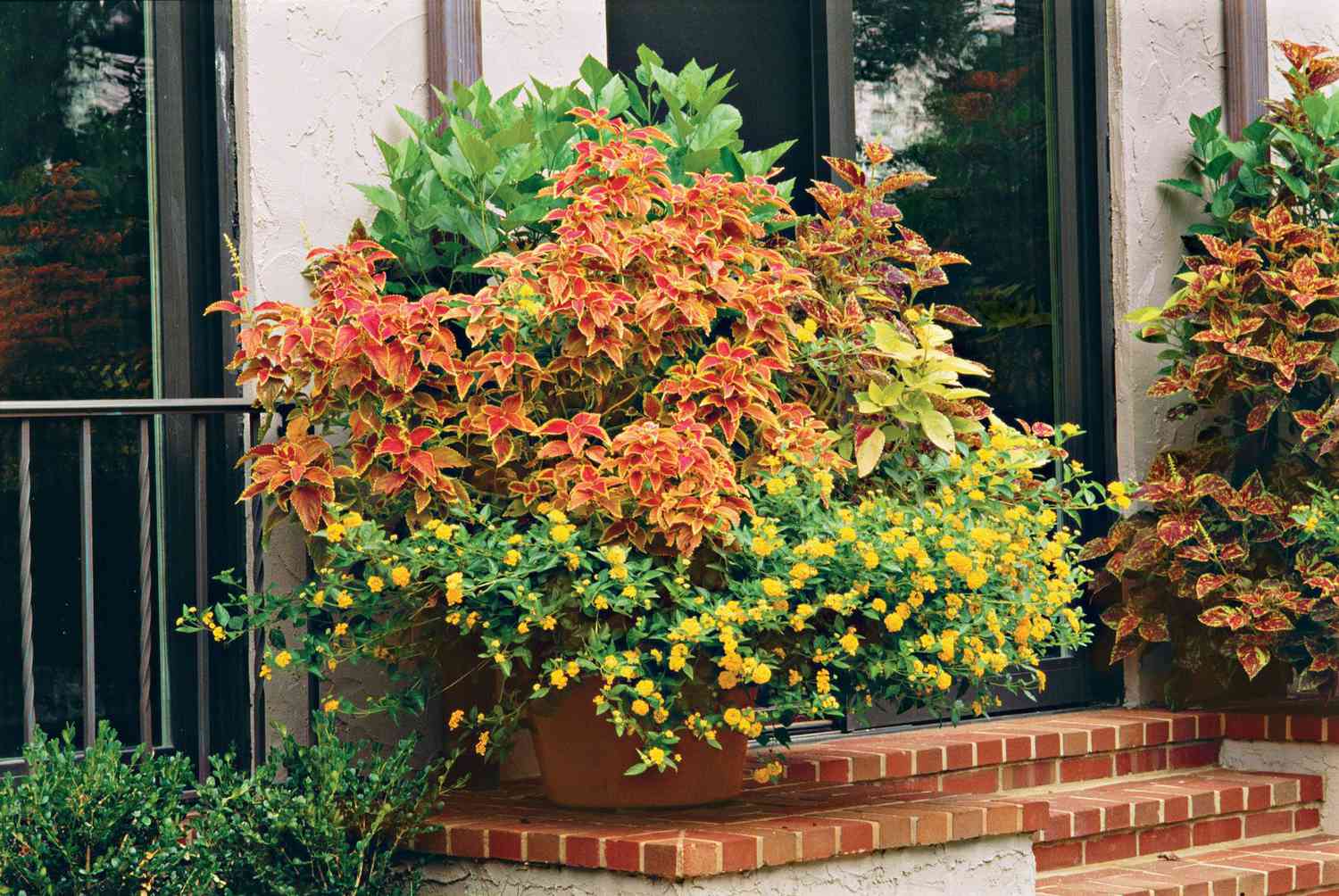When the air turns cool and crisp, it’s a good time to refresh containers. The heat and humidity-loving plants of summer are fading with the cooling temperatures. We’re waving goodbye to them—until next summer, at least. Fall is the season for plants that can thrive with less sun and chillier temps while still bringing the drama with blooms and foliage. It’s time to get your hands dirty and put those green thumbs to work on planting fall container gardens. We’ve collected a few of our favorite fall plants that will last in your container gardens all season long. We included classics like mums and zinnias as well as a few plants you might not already have on your autumn planting radar. Read on for our September-to-November favorites. What are your favorite fall plants for pots and hanging baskets?
Aster
- Botanical Name: Aster
- Sun Exposure: Full sun, partial shade
- Soil Type: Moist, well-drained, clay, loam
- Soil pH: Acid, alkaline, neutral
These perennials are loaded with daisy-like flowers in white, purple, blue, or pink that also attract bees and butterflies. They bloom in late summer and fall. Asters can require sun or shade, depending on the species, so make sure to check plant labels. Add them to your containers for a pop of fall color and then plant them in the ground; asters are winter hardy in USDA Zones 4 to 8.
Begonia

- Botanical Name: Begonia
- Sun Exposure: Full sun, shade
- Soil Type: Moist, rich, well-drained
- Soil pH: Slightly acidic
Most types of begonias have fleshy leaves and bloom in summer and fall. But multiflora tuberous begonias—like the old favorite «Non-Stop» series—have abundant, showy flowers in a variety of colors that last late in the season, blooming until the first frost. Grow in full or part shade.
Chrysanthemum

- Botanical Name: Chrysanthemum
- Sun Exposure: Full sun
- Soil Type: Moist, well-drained, loam, sand
- Soil pH: Slightly acidic
When fall arrives, Southerners know that it’s time for mums. They’re the classic fall container plant, and you’ll rarely find a porch without a pot of mums or two come October. Mums like regular watering and full sun. Deadhead the flowers to keep your mums blooming.
Autumn Crocus

- Botanical Name: Colchicum autumnale
- Sun Exposure: Full sun, partial shade
- Soil Type: Moist, well-drained, loam, clay, sand
- Soil pH: Acid, alkaline, neutral
Colchicums are actually in the lily family and are also called meadow saffron, naked ladies, or autumn crocus. They produce pink, lilac, or white cup-shaped flowers on bare, leafless stalks (the foliage will make an appearance later). Bury the bulbs in your containers in late summer for a flower show in fall. This plant is toxic to people and pets.
Cosmos

- Botanical Name: Cosmos
- Sun Exposure: Full sun
- Soil Type: Well-drained, clay, loam, sand
- Soil pH: Alkaline, neutral
Cosmos is a sun-loving annual that will bloom all summer and into fall. The ferny foliage bears flowers that resemble daisies and come in many colors—crimson, pink, chocolate brown, yellow, orange, and gold, for starters. They also attract pollinators. Pinch stems after the first bloom to reduce height and encourage branching.
Globe Amaranth

- Botanical Name: Gomphrena globosa
- Sun Exposure: Full sun
- Soil Type: Moist, well-drained, sand, clay, loam, chalk
- Soil pH: Acid, alkaline, neutral
These long-blooming flowers offer garden color from summer through fall. They produce rounded, cloverlike flower heads in shades of purple, pink, magenta, red, orange, and white. The plants themselves are drought tolerant, and many selections make great container plants for full sun.
Helenium

- Botanical Name: Helenium autumnale
- Sun Exposure: Full sun
- Soil Type: Moist, well-drained
- Soil pH: Acid
Also known as sneezeweed and Helen’s flower, Heleniums are summer and fall bloomers that bear flowers with red, yellow, bronze, and copper petals surrounding dark centers—perfect colors for containers in autumn. These plants in the daisy family prefer to grow in full sun and can reach heights of 3 feet tall.
Impatiens

- Botanical Name: Impatiens spp.
- Sun Exposure: Partial shade, full shade
- Soil Type: Well-drained
- Soil pH: Acid
You may have planted your impatiens during the heat of summer, but many selections of impatiens will continue to bloom until killed by the first frost. Impatiens produce flowers in eye-catching, jewel-toned hues, including magenta, crimson, violet, pink, lilac, and white. They are great choices for shady and partly shady container gardens as well as flower beds.
Marigold

- Botanical Name: Tagetes spp.
- Sun Exposure: Full sun
- Soil Type: Moist, well-drained, clay, sand, loam
- Soil pH: Acid, alkaline, neutral
Marigolds add a dose of cheery color to containers because they continue to bloom into the fall when other annuals have finished producing flowers. French and African marigolds, particularly, produce an abundance of bright blooms in sunny spots until the first frost. They’re even used in Day of the Dead celebrations on Nov. 1 and 2.
Pansy

- Botanical Name: Viola cornuta
- Sun Exposure: Full sun, partial shade
- Soil Type: Moist, well-drained, clay, sand, loam
- Soil pH: Acid, neutral
Pansies and their relatives, violets and violas, are often treated as cool-season annuals because they don’t thrive in the heat. They’re enlisted to provide beds, containers, and borders with plenty of fall (and even winter!) garden color. In the South, they can last through winter to provide another season of blooms in spring.
Petunia

- Botanical Name: Petunia
- Sun Exposure: Full sun, partial shade
- Soil Type: Moist, well-drained
- Soil pH: Slightly acidic, neutral
In warm climates that generally stay above freezing, petunias can be grown as winter annuals. Plant them in containers in the fall, and you’ll be able to enjoy them throughout the autumn and winter months. Bring containers indoors for the night when there’s a cold snap to prolong the growing season.
Zinnia

- Botanical Name: Zinnia elegans
- Sun Exposure: Full sun
- Soil Type: Well-drained, loam
- Soil pH: Acid, alkaline, neutral
These beautiful bloomers produce bright flowers in shades of red, pink, coral, white, and yellow from spring until the first frost. In very humid climates, zinnias can even have a resurgence during the dry months of fall. Place in full sun and cut off faded flowers to encourage additional blooms.
Crossandra

- Botanical Name: Crossandra infundibuliformis
- Sun Exposure: Partial
- Soil Type: Moist, well-drained, loam
- Soil pH: Acid
Also called firecracker flower, Crossandra blooms from late August through early fall. It can withstand late-season heat waves with plenty of water. Leave it planted until the first frost. Here, we paired a spruce topiary with a fiery «Orange Marmalade» firecracker flower.
Echinacea

- Botanical Name: Echinacea purpurea
- Sun Exposure: Full sun, partial shade
- Soil Type: Moist, well-drained, clay, sand, loam
- Soil pH: Neutral
Sun-loving coneflowers show off their perky blooms throughout the summer and until the first frost. Deadheading spent blooms from these perennials will prolong flowering. If you’re craving fall color, newer varieties come in sunset-inspired hues sure to brighten your containers.
Mexican Bush Sage

- Botanical Name: Salvia leucantha
- Sun Exposure: Full sun, partial shade
- Soil Type: Moist, well-drained, loam, sand
- Soil pH: Alkaline, neutral
Add height to fall containers with Mexican bush sage, a late-blooming species hardy to USDA Zone 8 that blooms throughout the fall (in the Tropical South, it’ll grow until spring). This drought-tolerant evergreen shrub produces tall, spiky purple flowers. Plant it in well-draining soil in a sunny spot.
Ornamental Cabbage and Kale

- Botanical Name: Brassica oleracea
- Sun Exposure: Full sun
- Soil Type: Moist, rich, well-drained
- Soil pH: Slightly acidic
These cool-weather annuals perform well in containers and deliver leafy fall color. Give them moist, well-drained soil and full or part sun, and they’ll stay happy throughout fall and winter in the South.
Ornamental Peppers

- Botanical Name: Capsicum annuum
- Sun Exposure: Full sun
- Soil Type: Well-drained, loam, clay, sand
- Soil pH: Acid, alkaline, neutral
Spice up fall containers with ornamental peppers. These vibrant peppers come in a variety of shapes, colors, and textures for growing in a sunny spot. And they are remarkably resilient, surviving snappy temperatures in fall. You can harvest the peppers before the first frost for cooking—just know they tend to be very, very hot.
Snapdragons

- Botanical Name: Antirrhinum majus
- Sun Exposure: Full sun, partial shade
- Soil Type: Well-drained, rich
- Soil pH: Neutral
Snapdragons prefer cool temperatures, which you might have suspected when they fried in the summer heat. Now is a great time to add them to containers, where they will bloom long after many flowers. Set them in a sunny spot and give them extra water whenever freezing temperatures arrive. If you live in USDA Zone 7 or warmer, they will survive the winter to bloom again in spring.
Goldenrod

- Botanical Name: Solidago
- Sun Exposure: Full sun, partial shade
- Soil Type: Well-drained, clay, loam
- Soil pH: Acid
Fluffy goldenrod shows off its bright yellow color in late summer and fall. Its seeds attract birds, and butterflies and bees also visit the plants well into October. Goldenrod is not only attractive, but it’s also easy to care for. Growing in pots helps control the plant’s spread. Deadhead the flowers to extend the length of the blooming season.
Coral Bells

- Botanical Name: Heuchera spp.
- Sun Exposure: Full sun, partial
- Soil Type: Moist, rich, well-drained
- Soil pH: Acid, neutral
The variety of colors of coral bells makes them perfect for a container garden in a fall palette. Here, ‘Sparkling Burgundy’ heuchera brings warmth to loropetalum, snapdragons, and violas. They also feature more color when their red, white, orange, or pink flowers bloom through fall. Deadheading will ensure continuous blooms. Coral bells like partial shade and well-drained soil to thrive.
Lantana

- Botanical Name: Lantana camara
- Sun Exposure: Full sun
- Soil Type: Well-drained
- Soil pH: Neutral
The bright colors of lantana add a bit of cheer to a fall-hued container. Shown, yellow clusters of lantana accentuate more subtle shades of coleus. Lantana likes full sun and moist soil. Overwinter potted lantana in an unheated room that doesn’t get colder than 55 degrees Fahrenheit. They can bloom continuously year-round in warmer climates. Further north, you’ll have yellow, orange, pink, red, white, or blue flowers from spring through fall. Deadhead to encourage more blooms.
Coleus

- Botanical Name: Coleus scutellarioides
- Sun Exposure: Full sun, shade
- Soil Type: Well-drained, rich
- Soil pH: Slightly acidic, neutral
Grow coleus in pots year-round. They come in a variety of colors, making them the perfect addition to a mixed fall container. Coleus plants don’t like the cold and they won’t survive a frost, so bring them indoors when the weather turns chilly if you want to keep them for spring. Place them in a sunny south- or southeast-facing window inside, and water only as necessary. There are many varieties of coleus, and some prefer more shade than others. Outdoors, make sure to provide the amount of light your variety needs.